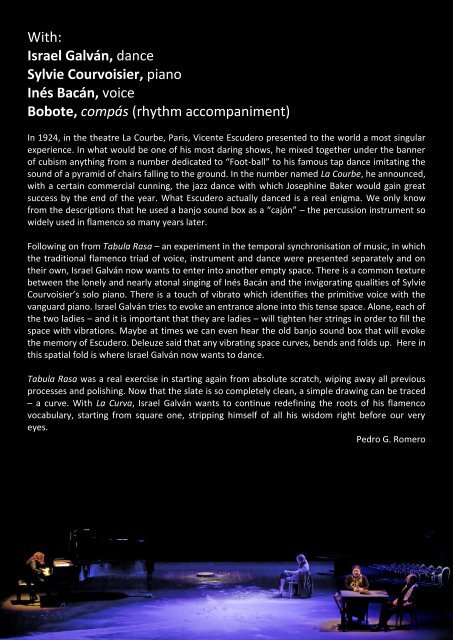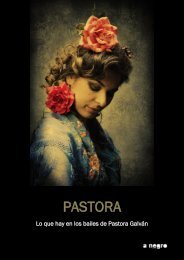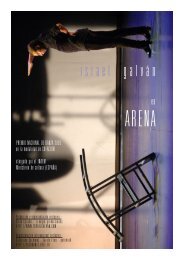Israel Galván - A Negro Producciones
Israel Galván - A Negro Producciones
Israel Galván - A Negro Producciones
You also want an ePaper? Increase the reach of your titles
YUMPU automatically turns print PDFs into web optimized ePapers that Google loves.
With:<br />
<strong>Israel</strong> <strong>Galván</strong>, dance<br />
Sylvie Courvoisier, piano<br />
Inés Bacán, voice<br />
Bobote, compás (rhythm accompaniment)<br />
In 1924, in the theatre La Courbe, Paris, Vicente Escudero presented to the world a most singular<br />
experience. In what would be one of his most daring shows, he mixed together under the banner<br />
of cubism anything from a number dedicated to “Foot-ball” to his famous tap dance imitating the<br />
sound of a pyramid of chairs falling to the ground. In the number named La Courbe, he announced,<br />
with a certain commercial cunning, the jazz dance with which Josephine Baker would gain great<br />
success by the end of the year. What Escudero actually danced is a real enigma. We only know<br />
from the descriptions that he used a banjo sound box as a “cajón” – the percussion instrument so<br />
widely used in flamenco so many years later.<br />
Following on from Tabula Rasa – an experiment in the temporal synchronisation of music, in which<br />
the traditional flamenco triad of voice, instrument and dance were presented separately and on<br />
their own, <strong>Israel</strong> <strong>Galván</strong> now wants to enter into another empty space. There is a common texture<br />
between the lonely and nearly atonal singing of Inés Bacán and the invigorating qualities of Sylvie<br />
Courvoisier’s solo piano. There is a touch of vibrato which identifies the primitive voice with the<br />
vanguard piano. <strong>Israel</strong> <strong>Galván</strong> tries to evoke an entrance alone into this tense space. Alone, each of<br />
the two ladies – and it is important that they are ladies – will tighten her strings in order to fill the<br />
space with vibrations. Maybe at times we can even hear the old banjo sound box that will evoke<br />
the memory of Escudero. Deleuze said that any vibrating space curves, bends and folds up. Here in<br />
this spatial fold is where <strong>Israel</strong> <strong>Galván</strong> now wants to dance.<br />
Tabula Rasa was a real exercise in starting again from absolute scratch, wiping away all previous<br />
processes and polishing. Now that the slate is so completely clean, a simple drawing can be traced<br />
– a curve. With La Curva, <strong>Israel</strong> <strong>Galván</strong> wants to continue redefining the roots of his flamenco<br />
vocabulary, starting from square one, stripping himself of all his wisdom right before our very<br />
eyes.<br />
Pedro G. Romero




